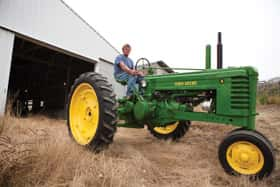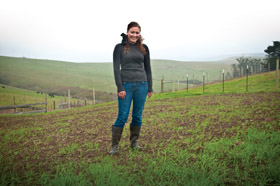
Cows graze alongside a school at Walker Creek Ranch in Marshall. At Skywalker Ranch in Nicasio, grapevines thrive on the same property as a high-tech sound facility. Farther along the road, the Lafranchi family’s pumpkin patch pairs traditional growing with a dairy producing high-quality cheeses that make their way into the best markets. Diverse purposes, to be sure, but they have in common an important designation. They all fall under the purview of the
Marin Agricultural Land Trust (MALT).
The pastoral landscapes of Marin County today are in marked contrast to the vision prevalent more than three decades ago, when biologist Phyllis Faber and late rancher Ellen Straus founded MALT. Then, young people were leaving the farms, and development seemed a given, with the prospect of a future defined by houses dotting the hillsides and roads cutting ribbons of concrete through pastures. The movement to save the land was taking hold, though, and Dr. Martin Griffin and a group of committed environmentalists had already engaged in a big fight to save thousands of acres of west Marin from development, scoring a big win with the creation of the Point Reyes National Seashore in 1976. The time was right for MALT.
The organization began to build a record of accomplishments, and, so far, it’s preserved 71 properties and more than 45,000 acres of land. As the number grows, so does the impact on the larger community. “As we’re protecting more farms, we’re starting to see these contiguous farming areas come together,” says Deirdre Holbrook, MALT’s director of outreach and communications, explaining that having adjacent properties aids in protecting wildlife corridors, preserving habitat and ensuring proper management of creeks and streams.
An innovative model
At the heart of MALT’s work is conservation easements, a model in which the organization raises money to purchase development rights to a property and retire them, thus ensuring the use of the land for agricultural purposes in perpetuity. The owner continues to own and care for the land and can even eventually sell it, but it must be used for agriculture. “The easement is forever. It remains with the property regardless of who owns it,” says Holbrook.
While MALT’s primary goal is to preserve agricultural land, the sale of conservation easements is also beneficial for the farmers and ranchers. “Landowners come to us at a time when they need our help,” says Holbrook. For instance, a farmer might need capital to launch a new business, and selling development rights to MALT will provide funding for the venture. The Lafranchi family’s desire to start a creamery is an example. They needed to buy more land to do it, and by selling the conservation easement on the property they already owned, they acquired the capital to start the Nicasio Valley Cheese Company.
In another situation, a family might be facing an issue with estate taxes after a farmer passes away, and rather than give up the farm, it can sell its conservation easement to MALT. “Without MALT’s help to deal with estate taxes, a family might have to sell the farm or a portion of it. They might also have to do something like sell off a herd of cattle that could cause the operation to lose value,” Holbrook explains. The Thornton Ranch in Tomales turned to MALT for help to save its farm after the family had already grappled with particularly difficult estate tax problems that forced it to sell livestock.
In yet another scenario, the goal might be to help a farm acquire property it needs to ensure its survival. The Moretti family, which has operated a dairy in Fallon since the 1930s, was leasing pastureland that was essentially in the middle of its property. When the parcel went up for sale for development, the Morettis had the right of first refusal, and they appealed to MALT for assistance in purchasing it. “We were able to draw on support from individual donors to save the land and keep this organic dairy alive,” says Holbrook, explaining that if the Morettis had lost access to the land, they would have lost their organic designation and could have lost their business. “A lot of smaller dairies are converting to organic. It gives them an edge to compete with the Central Valley,” she says.
In addition, farms and ranches are part of a larger business network, so MALT’s efforts affect a whole range of workers, including large-animal veterinarians, truck drivers, butchers and owners of feed and fuel stores. “[Farms] need a whole community to support the work they do,” she says. “If a quantity of ranchers were to go out of business, the infrastructure would collapse, and the remaining farmers would have difficulty staying in business.”
A new chapter 
“Most people would agree that farmland in Marin is worth conserving because of the multiple benefits it provides us,” says MALT’s Executive Director Jamison Watts, citing fresh, local food; wildlife habitat; recreation opportunities; clean air and water; open space; and the rural landscape. He also recognizes the economic benefits, but points to a philosophical component as well. “It’s about preserving that all-important link we have to the earth,” he says. “When land becomes a member of our family, so to speak, it’s possible to forever protect the interwoven fabric of fertile farms and rangelands, healthy watersheds and the agricultural heritage, economies and biodiversity it sustains for all of us, as well as those who will come after us.”
Watts arrived on the scene in January 2013, filling the position left vacant when Bob Berner retired after 28 years in the position. It’s a new chapter for MALT, as the organization identifies new priorities and moves in new directions. “I feel MALT is coming together as an organization with a better understanding of our common goals and strategic priorities,” says Watts, who brings previous experience as executive director of the Northern California Regional Land Trust to the table, along with an entrepreneurial business model that made that trust financially successful. “I believe my experience growing the budget of another land trust in the northern Sacramento valley by nearly 600 percent will benefit MALT by helping us become more adaptable to changing economic and environmental conditions,” he says.
“In the years to come, I expect MALT to be more efficient, innovative and adaptive in the protection of Marin’s working landscape through its various programs. I also see our stewardship program playing a larger and larger role working with our partners to help agriculturalists meet the many challenges of being economically viable and environmentally sustainable.”
“The stewardship is really the forever of what we do,” says Holbrook, explaining that MALT monitors all the property it preserves. Each year, a team visits and walks through each property with the owner to gather information and works with the owner to define ways MALT can help. The annual walk-through lets the stewardship team monitor plant communities and identify the need for improvements, which may include things such as erosion control. “We really become a partner with the farmers or ranchers and become a resource for them,” she says.
Such a partnership exists with the Marin County Office of Education, which owns Walker Creek Ranch in Marshall and operates Marin County Outdoor School on the site. “We were one of the first Marin Agricultural Land Trust designated properties. … We had a lot to learn about being good stewards of the property,” says MCOE Deputy Superintendent Luke McCann. “We have a grazing lease with a local rancher who runs cattle on the property,” he says, then describes a problem with cattle going into a creek on the site and polluting the water.
In addition, MCOE worked with MALT to develop an agricultural management plan for Walker Creek Ranch to make agriculture and nature compatible. The plan includes keeping cattle out of the creek to prevent erosion. MCOE had to build exclusionary fencing and also fence off the main compound so the cattle would stay away from the buildings.
“Right now, we’re dealing with the issue of star thistle,” says McCann, explaining that it’s invasive and affects the ecosystem. He points out that local residents value sustainable agriculture and says, “We have a responsibility to steward our public lands.”
A new generation
When Straus and Faber launched MALT, young people were leaving the farms, but today the trend has reversed, and they’re returning from college with energy, an enthusiasm for agriculture and new ideas. Among them are Lynn Giacomini Stray of Point Reyes Farmstead Cheese Company, Jim Jensen of the John Jensen Ranch in Tomales and Amanda Moretti, who’s studying diary science and will be a third-generation rancher.
Marissa Thornton, a sixth-generation rancher descended from founders of the town of Marshall, is running the family ranch in Tomales alongside her father while they start a creamery. She’s experimenting with growing barley for a local brewery, which is a historic use of the land, and she also gave assistance to David Jablons and Tamara Hicks when they started Toluma Farms & Tomales Farmstead Creamery, a dairy, organic farm and creamery. “It’s this wonderful community out here that’s really connected,” says Holbrook.
Looking ahead
MALT has permanently preserved almost half the county’s privately owned farmland, and Watts expects more. “We’re not done,” he says. “It’s our intention to protect the remaining at-risk agricultural land in the county, approximately 55,000 more acres, by 2030. Just as critical, MALT will play a role in keeping these protected farms agriculturally viable and environmentally sustainable in the long term,” he adds.
“We have six farms and ranches we’re working to protect in the next two years,” says Holbrook, adding that MALT is in the process of raising public and private funds. “It’s crucial that we respond in a timely manner. We need to raise $11 million to protect those lands forever. We need a significant amount of support from individuals and family foundations—about half that total—to be successful. We can then leverage these contributions to raise matching public funds.”
MALT has a long list of individual donors, community partners and public agencies that provide support, as well as private foundations such as the Lucasfilm Foundation and the Bechtel Foundation, but the need is ongoing.
Outreach is important for fund-raising as well as public relations, and MALT offers a range of events that are fun but also educational. MALT Day at the Pumpkin Patch in October gives children and their families a chance to connect with sources of local foods. Among the activities, kids get to prepare their own pizzas using local ingredients and even make fresh mozzarella. They press apples to make fresh juice, and they can see farm animals up close and go on a hayride. Events such as hikes, farm tours and tastings are often low cost or free. “We want individuals and families to be able to access these farms and ranches and find out what they’re all about—to provide the opportunity for the public to come out and enjoy the land,” says Holbrook.
On the other end of the scale, Ranches and Rolling Hills Landscape Art Show and Sale, an annual event at Druid’s Hall on the Village Square in Nicasio, has raised more than $1 million for farm protection over 16 years. Each year, a group of artists creates new paintings of scenes on MALT farms for the event, and they’re on hand to talk to visitors about their art and the importance of saving agricultural land.
Coming up on July 27, Tour de MALT will take cyclists on a farm-to-farm ride through more than 30 properties with a farm-to-table lunch to follow. “We’re aiming to raise money through the ride,” says Holbrook. And on August 10, farmer Peter Martinelli, who’s on MALT’s board of directors, and Ken Cook, president and co-founder of Environmental Working Group (an environmental health and research and advocacy organization), will host a supper at Martinelli’s Fresh Run Farm in Bolinas as part of the “Meet the Locals” series. Guest chef Sarah Hodge of Cowgirl Creamery will prepare a meal from locally grown and foraged ingredients to raise awareness of local produce.
As they become more knowledgeable, Marin County residents have a growing appreciation for West Marin’s rural landscape. The principles, however, are much the same as they were when Phyllis Faber and Ellen Straus first took action to save the farms, and that work will continue. “MALT will play a role in keeping these protected lands agriculturally viable and environmentally sustainable in the long term,” says Watts. Agriculture is here to stay.
Perspectives on MALT: Finding Inspiration
MALT Executive Director Jamison Watts has family ties with noted naturalist John Muir (1838-1914) and grew up amid his books and belongings. “This background gave me an understanding of the nexus that exists between natural resources and working landscapes and the importance of ongoing land stewardship,” he says.
Perspectives on MALT: Saving West Marin
Dr. Martin Griffin recognized the threat to west Marin in the 1960s and 1970s and led effective action to prevent development. “I saw the dangers in West Marin and worked hard for many years to help save thousands of acres and open space,” he says. “Since its creation in 1980, MALT has acquired agricultural easements in West Marin. MALT has done a lot of good for Marin County, saving farmland and farm families outside the Point Reyes National Seashore.”
Perspectives on MALT: Preserving Integrity
Peter Martinelli of Fresh Run Farm in Bolinas has served on the MALT board of directors since 2008, and members of his family have supported the concept and been involved since the organization’s early days. Although his farm is not yet MALT-designated, he’s currently in negotiations to sell its conservation easement. “MALT is, on many levels, one of the best guarantors of Marin County agriculture,” he says. “With conservation easements, we’ve preserved not just the land but farming activity as well.”
Perspectives on MALT: Developing a Business
Sue Conley, artisan cheesemaker and a member of MALT’s board of directors, learned about MALT after moving to Point Reyes in 1989 and meeting Ellen Straus, who told her how difficult it was for farms to stay in business. Conley subsequently helped Ellen’s son, Albert Straus, market the family’s organic milk, which led her to establish Cowgirl Creamery with co-owner Peggy Smith. “MALT inspired our business,” says Conley, explaining that MALT held off development long enough for entrepreneurs like herself and Smith to get new businesses going. “It’s a very simple concept to support,” she says.
 Perspectives on MALT: Educating a New Generation
Perspectives on MALT: Educating a New Generation
The primary purpose of Walker Creek Ranch is to teach kids about nature and the outdoors, but it’s also a rare chance for students from Marin’s more populous areas to see a working ranch up close. “It’s a wonderful opportunity for children,” says Marin County Office of Education’s Luke McCann. In addition, he observes, “We have a generation of young people, learning about the importance of agriculture, coming forward and entering careers as organic farmers.”
Perspectives on MALT: Giving Support
MALT’s Deirdre Holbrook estimates that public agencies such as the Wildlife Conservation Board, the California State Coastal Conservancy and Caltrans provide 50 percent of MALT’s funding. About 3,500 individual donors contribute amounts of $40 and higher annually. “Many have been giving for many, many years—some for 33 years,” she says. “We really have a strong community of supporters.”
 Cows graze alongside a school at Walker Creek Ranch in Marshall. At Skywalker Ranch in Nicasio, grapevines thrive on the same property as a high-tech sound facility. Farther along the road, the Lafranchi family’s pumpkin patch pairs traditional growing with a dairy producing high-quality cheeses that make their way into the best markets. Diverse purposes, to be sure, but they have in common an important designation. They all fall under the purview of the Marin Agricultural Land Trust (MALT).
Cows graze alongside a school at Walker Creek Ranch in Marshall. At Skywalker Ranch in Nicasio, grapevines thrive on the same property as a high-tech sound facility. Farther along the road, the Lafranchi family’s pumpkin patch pairs traditional growing with a dairy producing high-quality cheeses that make their way into the best markets. Diverse purposes, to be sure, but they have in common an important designation. They all fall under the purview of the Marin Agricultural Land Trust (MALT).



 Perspectives on MALT
Perspectives on MALT
